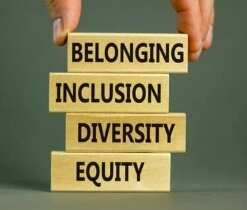by Manjit Shellis, Senior Education Advisor, Dec 2024 As UK schools look towards 2025, there’s a noticeable shift in priorities from the new government. In her speech to the Confederation of School Trusts, Education Secretary Bridget Phillipson emphasised the need for schools to foster a sense of belonging and prioritise wellbeing. Academic success is no longer the sole focus – student wellbeing and a sense of belonging are now recognised as critical components of education. This change, supported by initiatives like the upcoming Children’s Wellbeing Bill, presents a unique opportunity for schools to rethink how they approach both teaching and culture. Wherever in the world your school is located, it makes sense to reflect on the role that ‘belonging’ plays in the wellbeing and success of students. But what does belonging in schools look like in practice, and why is it so important?
Why Belonging Matters
Belonging isn’t just a nice-to-have – it’s essential for mental health, engagement, and academic success. Research shows that students who feel connected to their school community are more likely to:
• Achieve higher academic results
• Exhibit positive behaviour and stronger resilience
• Experience lower rates of anxiety and depression
• Stay motivated and engaged in their learning
Yet, belonging is an area where many UK schools are struggling. Only three-fifths of students feel they belong at school, and UK teens rank among the lowest globally in life satisfaction. The stakes are high: students who lack a sense of belonging are more prone to disengagement, antisocial behaviour, and poor mental health.
For teachers, this often translates into challenges with classroom behaviour and student focus. For school leaders, a lack of belonging can disrupt school culture and affect everything from Ofsted ratings to staff morale.
What Does It Mean to Flourish?
Flourishing is about more than just academic achievement. It’s about thriving emotionally, socially, and mentally. A flourishing child is confident, resilient and curious, equipped with the skills to face life’s challenges. Schools play a vital role in this, offering students the support and environment they need to flourish.
Building character strengths like perseverance, optimism and kindness is a key part of fostering flourishing. These strengths promote inclusivity, particularly for students with special educational needs and disabilities (SEND), ensuring every child feels valued and included. When schools focus on what students can achieve rather than their limitations, they create an environment where everyone can thrive..

Small Changes, Big Impact
Creating a sense of belonging doesn’t have to mean overhauling your entire approach. Simple, intentional actions can make a big difference.
For teachers: Build connections every day
• Welcome students warmly: A smile and a genuine greeting can set a positive tone for the day. Ask about hobbies or weekend plans during informal moments.
• Adapt lessons to include diverse voices: Representation matters, and inclusive content ensures all students feel seen and valued. For example, when teaching poetry, explore works by diverse authors.
• Celebrate achievements: Highlight academic and personal successes to build confidence and strengthen bonds with shout-outs in lessons or positive notes sent home.
• Use restorative practices: Conflict is natural, but restorative approaches can help rebuild relationships and reinforce belonging when conflicts arise. For example: “Can we talk about what happened earlier? I want to understand how you’re feeling and work together on a solution.”
For school leaders: Embed belonging into your school’s culture
• Celebrate diversity: Host assemblies, cultural events and classroom activities highlighting different perspectives and achievements.
• Empower student voices: Establish councils or feedback groups to give students a say in shaping their school experience.
• Invest in training and resources: Equip staff with tools and strategies to support inclusivity and mental health.
• Showcase your school’s values: Make belonging a core part of your mission statement and embed it into your policies.
Overcoming Common Challenges
Focusing on wellbeing and belonging can feel like an added pressure, especially in schools already stretched by tight budgets and high demands. However, belonging doesn’t need to add to your workload—it can enhance what you’re already doing.
For example:
• Time-saving resources: Tools and lesson plans designed to integrate wellbeing into the curriculum can save teachers time while promoting belonging. We have lots of resources that can help. Explore some of them here.
• Student leadership: Programmes like peer mentoring or buddy systems can strengthen relationships and reduce behaviour issues.
• Curriculum integration: Including diverse role models and character education across subjects naturally supports wellbeing and belonging without requiring separate initiatives. Explore the stories of our Historical Amazing People and related resources.
Looking to the Future
It looks as if the emphasis on wellbeing and belonging is set to grow. Schools that embrace this shift will not only see improvements in academic outcomes but also in their overall culture. Whether you’re a classroom teacher or a school leader, small, consistent actions can create a ripple effect, helping every student feel supported, included and ready to flourish.
If you’d like to talk to us about how you can foster belonging and wellbeing in your classroom or school get in touch. Alternatively explore our resources here.



